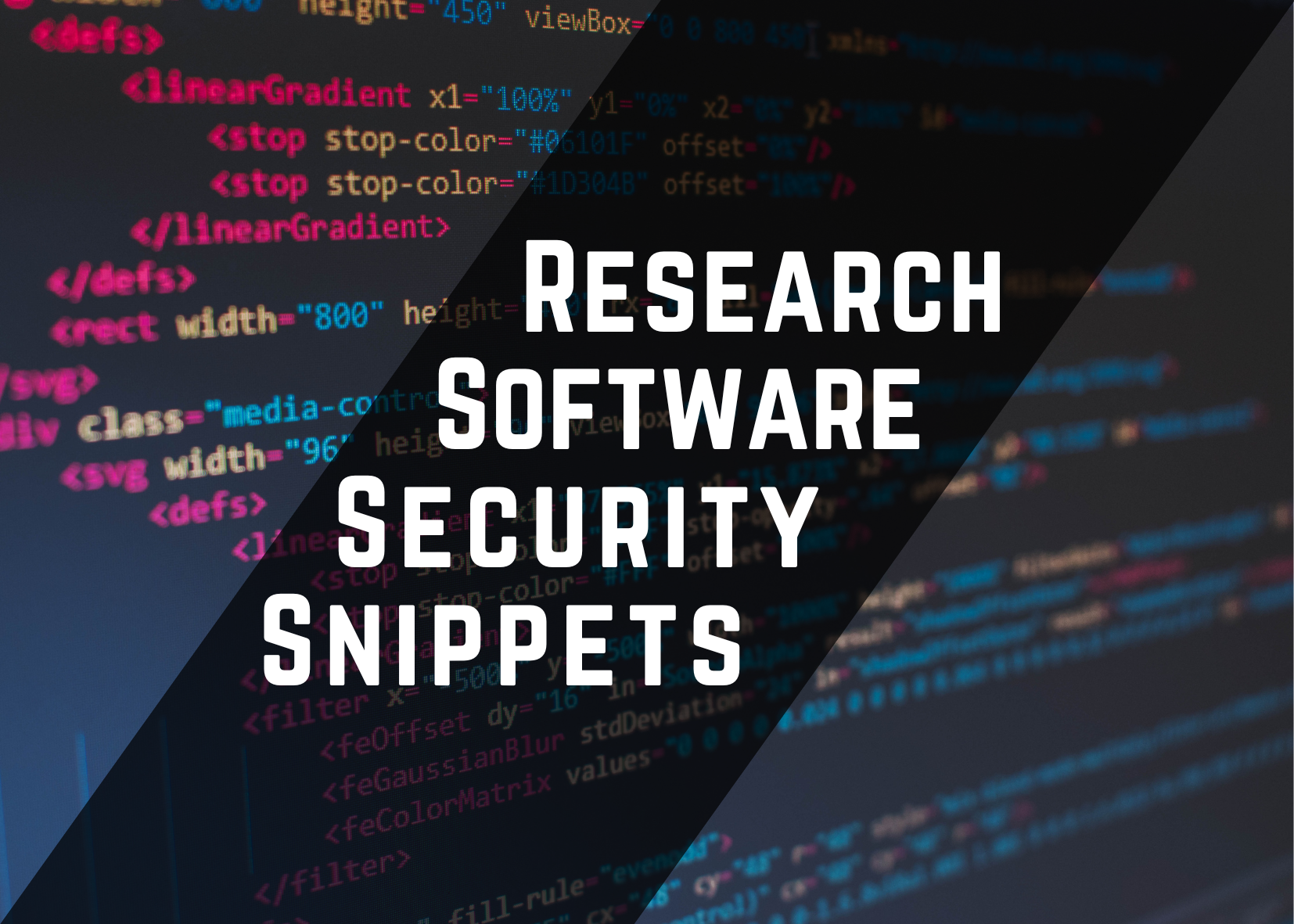Research Software Security Snippets #2
Posted on 17 July 2023
Research Software Security Snippets #2
 By SSI Fellow Alex Coleman.
By SSI Fellow Alex Coleman.
A big thank you to Samantha Finnigan, RSE from Durham for helping co-author this post and for advice on content.
In this instalment of Research Software Security Snippets, we're going to talk about secrets! Not those deep and dark things, but rather all those bits of information you need in your code for it to run that you don’t want shared with everyone else.
Secrets and Environments
Let’s start off by defining these secrets. A secret is something like an API key, a password, username, database key or authentication token that your code uses to run, but that is a private piece of information you wouldn’t want to share. Including these secrets publicly in our source code is a bad idea. They expose us to bad actors who could impersonate us to access systems or use APIs we’re paying for (some of a few potential bad examples). Secret leakage is a major cause of security incidents at companies: for example, Uber in 2022 was breached using hard coded admin credentials that allowed attackers to breach their privileged access management platform.
Leaking secrets is very easy to do. Often the biggest mistake can be hard coding them into our source code and (whilst trying to be good and using version control) committing this secret in-source-code into our version history. We might then push that to a public repository, and voila(!), our secret is publicly available on our public source repository!
Another way that secrets leak is through tools such as Docker. Docker is a containerisation tool that allows us to bundle software and its dependencies (including operating system dependencies) into a container we can share with others. In Docker we might use things like environment variables (more on those below) to manage secrets that allow our software to connect to a service, like a database, but these environment variables are still encoded within the container and anyone can view them if we make the container publicly available through a container repository such as Docker Hub.
Secrets are a really easy thing to accidentally share when we’re first learning about using version control tools like git. We’re trying our hardest to keep things versioned, and accidentally commit a file containing our secret. Once the file is in our git history it can be difficult/painful to extract it (especially if we don’t realise this immediately). The first thing to do when using secrets within our code is to separate them from our source code. Secrets shouldn’t live within our code, it’s much better to find a way to inject them when our code runs.
Separating code and secrets: Environment variables
The classic way to do this is with environment variables. Environment variables are named key/value pairs that exist within the system environment. We can retrieve the value using the environment variable name because they’re set outside our program. They have been historically used as a method for storing secrets which we can retrieve in our code:
# main.py import os print(os.environ[“TEST”]) $ export TEST=magic-key $ python main.py magic-keyFrom the simplified above example you can hopefully see how you could use environment variables to store secrets outside of your code but still retrieve them at run time.
To avoid having to explicitly set all these environment variables before you run your code there are a number of packages that let you specify a .env file (often called "dotenv") in which you pinpoint your secrets as key-value pairs. For instance (but not exhaustively), in Python there's decouple, in R you can use the default .Renviron file.
This allows you to start to separate your code and your secrets and do so in a convenient way. Environment variables aren't perfect but they are a good and easy entry point for starting to secure your code.
Keeping secrets out of the public eye
The .env file or .Renviron files should never be committed to version control, but allow you to handle secrets using configuration files on a project-by-project basis.
The .gitignore file is our friend in these situations. If you've used git for version control you may or may not be familiar with the .gitignore file. Sometimes all we want is to actually ignore a file from version control and make sure it isn't accidentally added and tracked.
The .gitignore file is just a text file that lives in the root of our repository. Each line in the file specifies a pattern of file/folder names to ignore. This allows us to easily specify specific files or patterns (file extensions) that should be ignored in our repository. For managing our secrets in a .env file, this means we just add .env as a line in our .gitignore, and that file won't be tracked by git, keeping our secrets out of version control. We should commit the .gitignore file into version control so that cloned versions of our repository will also ignore the files listed!
Docker provides similar functionality through the .dockerignore file. Accidentally copying .env files into our Docker images can be surprisingly easy, as the following example demonstrates:
FROM alpine:latest COPY . . CMD ["cat", ".env"]The COPY . . command in this Dockerfile was intended to copy our application files, but has a potentially unforeseen side-effect: it will copy dotfiles (files with a dot in front), too! This includes our .env file containing all our secrets:
$ echo "# THIS FILE SHOULD NOT BE COPIED!" > .env $ docker build --tag=test . $ docker run test # THIS FILE SHOULD NOT BE COPIED!Oops! .dockerignore uses exactly the same syntax as .gitignore, so an .env file can be easily excluded from the Docker image by committing a .dockerignore file with the following content into our repository:
**/*.envNow when we build and run our example container, the .env file is not included by the COPY . . command:
$ docker build --tag=test . $ docker run test cat: can't open '.env': No such file or directoryHowever, the downside of environment variables is that they are still plain text within our system, so if the system our code is running on is compromised bad actors can still get at our secrets!
Oops, I accidentally committed a secret. What now?
We've now learned how to keep secrets out of our Git repositories in the first place, but what happens if we accidentally commit and push them? It's too easy for something to slip through the net, despite implementing best practices like .gitignore and .dockerignore.
Third-party tools like GitGuardian (free for teams of 25 members or fewer) can enable us to take corrective action when the worst happens. GitGuardian scans repositories against a set of definitions for known types of secrets, and creates an "Incident" where a match is found. It can even be set up as part of a CI/CD pipeline, and send a notification to enable us to realise and revoke a leaked secret in real time.
This links to a key design principle: secrets should be revokable. We're familiar with the concept of changing our passwords for online services and websites, and it's a similar principle. Third-party APIs and services often employ an API key, so that we don't have to write code which needs access to our personal password. For example, DockerHub allows us to create API keys which scripts can be used to publish our containers, avoiding the need to provide our CI/CD scripts with a password.
API keys allow us to limit access to an application through the principle of least privilege. Instead of a password, which allows access to all functions of an application, an API key often provides the ability to give our applications only the permissions which they require: e.g. read-only access, or access to a limited set of resources. API keys can be easily revoked, removing the possibility for them to be used by a malicious actor, and limiting their permissions can limit or mitigate the damage that can be done if and when they do leak. However, before revoking an API key, it's sensible to work out what features of your application rely on it and may fail when they no longer have permission to access the resource, as this can cause other problems. When an API key gives few permissions, it may be more reasonable to create a new key and deploy it to the production environment, before revoking the compromised secret.
Tools such as the BFG repo cleaner can be used to alter git repository history, for example, to remove a secret-containing file that should never have been committed in the first place. In general, this approach should be applied with caution: never assume that by removing the secret from the repository, it's now gone. Once something has been published on the internet, for however little time, it should be considered compromised. While you can remove the file from the repository in this way, any leaked API keys also need to be revoked.
Conclusion
We've taken some tentative steps above to introduce ideas around code secrets and how we manage them. Separating our secrets and our code is a key step in keeping ourselves safe and ensuring our code is secure. Environment variables are a classic way to do this and are widely supported by the concept of "dotenv" files but aren't perfect. We also touched on how easy it is to accidentally include secrets in version control and within container images and suggest some tips for how to prevent this using ignore files. In future snippets, we'll dig into some more advanced approaches to managing secrets.

